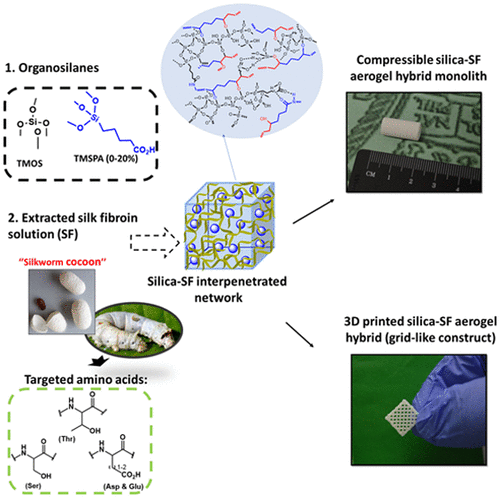当前位置:
X-MOL 学术
›
ACS Appl. Mater. Interfaces
›
论文详情
Our official English website, www.x-mol.net, welcomes your
feedback! (Note: you will need to create a separate account there.)
Compressible, Thermally Insulating, and Fire Retardant Aerogels through Self-Assembling Silk Fibroin Biopolymers Inside a Silica Structure—An Approach towards 3D Printing of Aerogels
ACS Applied Materials & Interfaces ( IF 8.3 ) Pub Date : 2018-06-04 00:00:00 , DOI: 10.1021/acsami.8b05856 Hajar Maleki 1 , Susan Montes 1 , Nastaran Hayati-Roodbari 1 , Florian Putz 1 , Nicola Huesing 1
ACS Applied Materials & Interfaces ( IF 8.3 ) Pub Date : 2018-06-04 00:00:00 , DOI: 10.1021/acsami.8b05856 Hajar Maleki 1 , Susan Montes 1 , Nastaran Hayati-Roodbari 1 , Florian Putz 1 , Nicola Huesing 1
Affiliation

|
Thanks to the exceptional materials properties of silica aerogels, this fascinating highly porous material has found high-performance and real-life applications in various modern industries. However, a requirement for a broadening of these applications is based on the further improvement of the aerogel properties, especially with regard to mechanical strength and postsynthesis processability with minimum compromise to the other physical properties. Here, we report an entirely novel, simple, and aqueous-based synthesis approach to prepare mechanically robust aerogel hybrids by cogelation of silk fibroin (SF) biopolymer extracted from silkworm cocoons. The synthesis is based on sequential processes of acid catalyzed (physical) cross-linking of the SF biopolymer and simultaneous polycondensation of tetramethylorthosilicate (TMOS) in the presence of 5-(trimethoxysilyl)pentanoic acid (TMSPA) as a coupling agent and subsequent solvent exchange and supercritical drying. Extensive characterization by solid-state 1H NMR, 29Si NMR, and 2D 1H–29Si heteronuclear correlation (HETCOR) MAS NMR spectroscopy as well as various microscopic techniques (SEM, TEM) and mechanical assessment confirmed the molecular-level homogeneity of the hybrid nanostructure. The developed silica–SF aerogel hybrids contained an improved set of material properties, such as low density (ρb,average = 0.11–0.2 g cm–3), high porosity (∼90%), high specific surface area (∼400–800 m2 g–1), and excellent flexibility in compression (up to 80% of strain) with three orders of magnitude improvement in the Young’s modulus over that of pristine silica aerogels. In addition, the silica–SF hybrid aerogels are fire retardant and demonstrated excellent thermal insulation performance with thermal conductivities (λ) of 0.033–0.039 W m–1 K–1. As a further advantage, the formulated hybrid silica–SF aerogel showed an excellent printability in the wet state using a microextrusion-based 3D printing approach. The printed structures had comparable properties to their monolith counterparts, improving postsynthesis processing or shaping of the silica aerogels significantly. Finally, the hybrid silica–SF aerogels reported here represent significant progress for a mechanically customized and robust aerogel for multipurpose applications, namely, as a customized thermal insulation material or as a dual porous open-cell biomaterial used in regenerative medicine.
中文翻译:

通过在二氧化硅结构内自组装丝素蛋白生物聚合物的可压缩、隔热和阻燃气凝胶——一种气凝胶 3D 打印方法
由于二氧化硅气凝胶的特殊材料特性,这种迷人的高度多孔材料已在各种现代工业中找到了高性能和实际应用。然而,拓宽这些应用的要求是基于气凝胶性能的进一步改进,特别是在机械强度和合成后加工性方面,同时对其他物理性能的影响最小。在这里,我们报告了一种全新的、简单的、基于水的合成方法,通过从蚕茧中提取的丝素蛋白 (SF) 生物聚合物的共凝胶来制备机械坚固的气凝胶混合物。该合成基于 SF 生物聚合物的酸催化(物理)交联和在 5-(三甲氧基甲硅烷基)戊酸(TMSPA)作为偶联剂和随后的溶剂交换存在下同时缩聚原硅酸四甲酯(TMOS)的顺序过程和超临界干燥。固态的广泛表征1 H NMR、29 Si NMR 和 2D 1 H- 29 Si 异核相关 (HETCOR) MAS NMR 光谱以及各种显微技术 (SEM、TEM) 和机械评估证实了混合纳米结构的分子水平均匀性。开发的二氧化硅-SF 气凝胶混合物包含一组改进的材料特性,例如低密度(ρ b,平均值= 0.11-0.2 g cm -3)、高孔隙率(~90%)、高比表面积(~400- 800 米2克–1),以及出色的压缩灵活性(高达 80% 的应变),杨氏模量比原始二氧化硅气凝胶的杨氏模量提高了三个数量级。此外,二氧化硅-SF 混合气凝胶具有阻燃性,并表现出优异的隔热性能,热导率 (λ) 为 0.033–0.039 W m –1 K –1. 作为另一个优势,配制的混合二氧化硅-SF 气凝胶使用基于微挤出的 3D 打印方法在湿态下表现出出色的可打印性。印刷结构具有与其整体对应物相当的特性,显着改善了二氧化硅气凝胶的合成后加工或成型。最后,本文报道的混合二氧化硅-SF 气凝胶代表了机械定制和坚固的气凝胶用于多用途应用的重大进展,即作为定制隔热材料或作为再生医学中使用的双多孔开孔生物材料。
更新日期:2018-06-04
中文翻译:

通过在二氧化硅结构内自组装丝素蛋白生物聚合物的可压缩、隔热和阻燃气凝胶——一种气凝胶 3D 打印方法
由于二氧化硅气凝胶的特殊材料特性,这种迷人的高度多孔材料已在各种现代工业中找到了高性能和实际应用。然而,拓宽这些应用的要求是基于气凝胶性能的进一步改进,特别是在机械强度和合成后加工性方面,同时对其他物理性能的影响最小。在这里,我们报告了一种全新的、简单的、基于水的合成方法,通过从蚕茧中提取的丝素蛋白 (SF) 生物聚合物的共凝胶来制备机械坚固的气凝胶混合物。该合成基于 SF 生物聚合物的酸催化(物理)交联和在 5-(三甲氧基甲硅烷基)戊酸(TMSPA)作为偶联剂和随后的溶剂交换存在下同时缩聚原硅酸四甲酯(TMOS)的顺序过程和超临界干燥。固态的广泛表征1 H NMR、29 Si NMR 和 2D 1 H- 29 Si 异核相关 (HETCOR) MAS NMR 光谱以及各种显微技术 (SEM、TEM) 和机械评估证实了混合纳米结构的分子水平均匀性。开发的二氧化硅-SF 气凝胶混合物包含一组改进的材料特性,例如低密度(ρ b,平均值= 0.11-0.2 g cm -3)、高孔隙率(~90%)、高比表面积(~400- 800 米2克–1),以及出色的压缩灵活性(高达 80% 的应变),杨氏模量比原始二氧化硅气凝胶的杨氏模量提高了三个数量级。此外,二氧化硅-SF 混合气凝胶具有阻燃性,并表现出优异的隔热性能,热导率 (λ) 为 0.033–0.039 W m –1 K –1. 作为另一个优势,配制的混合二氧化硅-SF 气凝胶使用基于微挤出的 3D 打印方法在湿态下表现出出色的可打印性。印刷结构具有与其整体对应物相当的特性,显着改善了二氧化硅气凝胶的合成后加工或成型。最后,本文报道的混合二氧化硅-SF 气凝胶代表了机械定制和坚固的气凝胶用于多用途应用的重大进展,即作为定制隔热材料或作为再生医学中使用的双多孔开孔生物材料。


















































 京公网安备 11010802027423号
京公网安备 11010802027423号